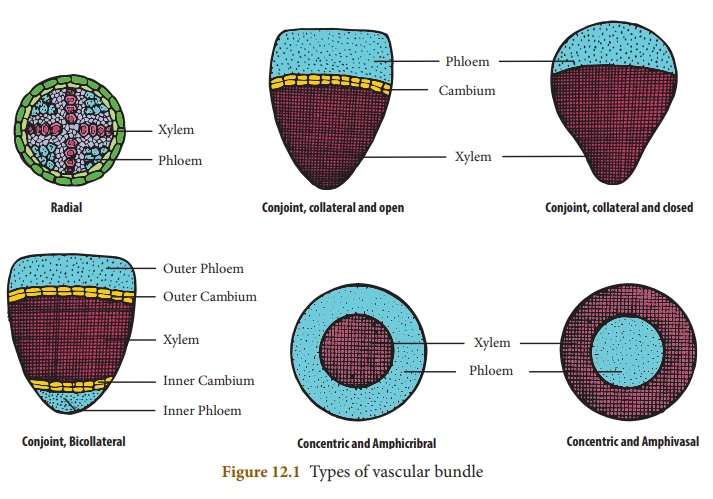three types | Anatomy and Plant Physiology - Tissue system | 10th Science : Chapter 12 : Anatomy and Plant Physiology
Chapter: 10th Science : Chapter 12 : Anatomy and Plant Physiology
Tissue system
Tissue
system
Sachs (1875) classified
tissue system in plants into three types
i) Dermal or Epidermal tissue system
ii) Ground tissue system
iii) Vascular tissue system
The functions of these
tissues are given in Table 12.1.
1. Dermal or Epidermal Tissue System
It consists of
epidermis, stomata and epidermal outgrowths. Epidermis is the outer most layer.
It has many minute pores called stomata.

Cuticle is present on
the outer wall of epidermis to check evaporation of water. Trichomes and root
hairs are the epidermal outgrowths.
Functions:
i) Epidermis protects the inner tissues.
ii) Stomata helps in transpiration.
iii) Root hairs help in absorption of water and minerals.
2. Ground Tissue System
It includes all the
tissues of the plant body except epidermal and vascular tissues like (i) Cortex
(ii) Endodermis (iii) Pericycle (iv) Pith
3. Vascular Tissue System
It consists of xylem and
phloem tissues. They are present in the form of bundles called vascular
bundles. Xylem conducts water and minarals to different parts of the plant.
Phloem conducts food materials to different parts of the plant.
There are three
different types of vascular bundles namely (i) Radial (ii) Conjoint (iii)
Concentric
(i) Radial Bundles
Xylem and phloem are
present in different radii alternating with each other. e.g. roots
(ii) Conjoint bundles
Xylem and phloem lie on
the same radius.
There are two types of
conjoint bundles.
a) Collateral
Xylem lies towards the
centre and phloem lies towards the periphery.
When cambium is present
in collateral bundles, it is called open. e.g. dicot stem and collateral bundle
without cambium is called closed. e.g. monocot stem.
b) Bicollateral
In this type of bundle,
the phloem is present on both outer and inner side of xylem. e.g. Cucurbita
(iii) Concentric Bundles
Vascular bundle in which
xylem completely surrounds the phloem or viceversa is called concentric
vascular bundle. It is of two types:
1. Amphivasal: Xylem
surrounds phloem.
e.g. Dracaena
2. Amphicribral: Phloem surrounds xylem. e.g. Ferns
Endarch: Protoxylem lies towards
the centre and metaxylem lies towards the periphery. e.g. stem.
Exarch : Protoxylem lies towards
the periphery and metaxylem lies towards the centre. e.g. roots.

Related Topics